Top 12 RFP Software for Strategic Response Management 2025
Discover the top software solutions for strategic response management in 2025. Choose the best fit for your organization today!

CROs, Sales leaders, and proposal teams often face delays and inconsistency when managing RFPs with disconnected tools. Spreadsheets and emails can't match the speed or scale required. Strategic Response Management, or SRM, is the discipline of managing high-stakes responses like RFPs, RFIs, security questionnaires, and due diligence docs with precision, speed, and collaboration. But SRM isn’t just another layer of admin work. It directly impacts revenue, reputation, and win rates.
As 88 percent of organizations are already deploying or planning to deploy generative AI by 2025, the opportunity is clear. However, most teams still lack the right frameworks and software to apply AI meaningfully within SRM workflows.
In this blog, we explore the top software solutions for strategic response management in 2025. If you’re looking to scale your team’s impact and finally move beyond the firefighting, this guide will help you choose the right solution with confidence.
Key Takeaways
- Strategic Response Management demands specialized AI-powered tools that centralize content, automate drafting, and enable seamless multi-team collaboration to handle complex RFP workflows effectively.
- Top software solutions differ in integration capabilities, ease of use, and security features—choosing the right platform depends on your team’s size, existing tech stack, and industry requirements.
- Effective SRM software improves proposal consistency and accuracy by managing version control, suggesting relevant content, and automating compliance checks, reducing manual errors.
- Future SRM trends focus on AI-driven bid intelligence, predictive scoring, and deep CRM integration to accelerate response times and boost win rates while empowering dedicated SRM teams.
- Investing in modern SRM tools delivers long-term benefits such as increased revenue, improved team alignment, and better audit readiness, making it a strategic priority for competitive organizations.
What Is Strategic Response Management in the Context of RFP Software
Strategic Response Management (SRM) is the structured handling of high-volume RFPs, RFIs, and due diligence questionnaires using scalable processes. Instead of treating every response as a new project, SRM applies repeatable systems to manage inputs, content, and timelines across teams. It helps sales and revenue teams meet deadlines, improve response quality, and protect brand consistency.
For example, without SRM, a proposal manager might chase down answers from ten people using email threads and shared folders. With SRM, the manager uses shared libraries, tracked workflows, and pre-approved content to complete the same task in half the time.
How SRM Is Different From Traditional Proposal Management?
Basic proposal management often means working out of shared drives, Google Docs, and long email threads. Every RFP feels like starting from scratch, with proposal managers chasing inputs and SMEs duplicating effort across responses. SRM replaces this reactive model with a centralized system that enables scalable operations.
Let’s look at a real-world example.
A solutions team at a mid-sized SaaS company receives 25 RFPs per week. Without SRM, each proposal requires manual formatting, content hunting, and hours of back-and-forth across departments. With SRM in place, content is pre-approved, roles are clearly defined, and input is auto-routed to the right SMEs, cutting time spent per response by over 50%.
Key differences between basic proposal handling and SRM:
SRM also enables response managers to build reusable assets and track which messages perform best, helping teams improve over time instead of reinventing the wheel with each submission.
Why Strategic Response Management Needs Specialized Tools
General tools like spreadsheets or project boards lack the structure and intelligence needed for RFP workflows. Sales and solutions teams need platforms that can manage complexity, not just tasks.
Key capabilities required for effective SRM:
- Version control: Ensure the latest approved answers are always used.
- AI-assisted suggestions: Speed up SME contributions by auto-surfacing relevant content.
- Multi-stakeholder workflows: Route questions to multiple reviewers, track status, and maintain accountability.
- Compliance and access control: Ensure content security and auditability at scale.
- Analytics: Track win rates, response time, and team performance to optimize efforts.
Why generic tools fall short:
Teams handling 10+ RFPs weekly can’t afford the delays, missed deadlines, or brand inconsistency that come with general tools. This is where AI RFP agents like Inventive AI fill the gap by aligning all contributors in one intelligent system.
Also Read: The Ultimate Guide to Software RFPs: How to Write and Respond to Software RFPs
Now that we’ve defined SRM, let’s explore the top software solutions shaping this space in 2025
Top 12 Software Solutions for Strategic Response Management in 2025
Responding to RFPs, RFIs, and security questionnaires can be time-consuming and complex. Strategic Response Management (SRM) software powered by AI helps teams eliminate hours of manual work, centralize content, and ensure accuracy across every submission. These tools streamline collaboration, maintain compliance with client requirements, and improve win rates by cutting drafting time and reducing repetitive tasks.
Below is a comparison of the top 12 AI-driven SRM tools that stand out in 2025 for proposal and response content.
Let's take a closer look at each solution in detail:
1. Inventive AI

G2 Rating: 5/5
Inventive AI is built for teams managing complex and compliance-sensitive RFPs, RFIs, and security questionnaires. Unlike traditional proposal tools, it uses AI to streamline the entire response lifecycle, from drafting to compliance checks, ensuring accuracy, speed, and scalability. Whether responding to enterprise-level bids or handling high-volume questionnaires, Inventive AI centralizes knowledge, enforces consistency, and enables faster turnaround without sacrificing quality.
Its standout capabilities, such as AI-powered conflict detection and predictive win themes, make it a trusted platform for proposal managers, sales leaders, and operations teams working in competitive and regulated environments.
Key Features
- AI RFP Agent
Generates accurate first drafts for RFPs, RFIs, and security questionnaires with up to 95% accuracy and reduces response time by as much as 90 percent. The system adapts to past responses and organizational data to deliver contextually correct answers immediately. - Centralized Knowledge Hub
Consolidates critical documentation, including policies, certifications, and approved content, into a single repository. This eliminates reliance on outdated spreadsheets or scattered files and ensures every response is consistent and current. - AI Content Management
Flags conflicting or outdated information before submission, reducing risks tied to compliance errors and strengthening credibility during vendor due diligence. - Win Themes Engine
Surfaces tailored value propositions by analyzing inputs from CRMs, internal communication tools, and past proposals. This helps teams highlight differentiators that resonate with evaluators and decision makers. - Real-Time Collaboration
Brings sales, compliance, and technical teams into one workspace. Role-based permissions and live editing ensure responses meet both business goals and client requirements. - Advanced Analytics and Reporting
Provides visibility into response times, win-rate metrics, and content usage patterns. These insights help teams refine workflows and strategies continuously.
Pros
- Designed for compliance-heavy and competitive industries
- Conflict detection engine improves reliability of responses
- Proven speed improvements (up to 90 percent faster drafting) and measurable win-rate gains
- Scales from mid-sized teams to global enterprises
Cons
- Requires structured onboarding for teams new to AI-first workflows
- A broad feature set may be more than smaller organizations need
Pricing
Custom pricing based on team size, proposal volume, and feature set. Typically suited for enterprises and growing firms with complex RFP workflows.
Best For
Inventive AI is best suited for:
- Proposal managers handling high-volume RFPs with strict accuracy requirements
- Sales leaders who want faster response times without sacrificing quality
- Teams where speed, precision, and credibility directly influence deal outcomes
It performs best in high-stakes RFP environments where even small oversights can impact credibility, helping teams deliver proposals with confidence and precision.
Download the Insider Case Study
2. Loopio

G2 Rating: 4.7/5
Loopio is a market leader in RFP response management, serving over 1,500 companies with its strong content management and automation capabilities. The platform emphasizes trust, security, and scalability, making it well-suited for enterprises that manage complex proposals across multiple teams and geographies.
Key Features
- Intelligent Automation
Reduces repetitive manual tasks while ensuring oversight and compliance standards are met. - Enhanced Library Management
Organizes and maintains content across product lines, regions, and languages, ensuring consistent and accurate responses. - Advanced Collaboration
Supports global and cross-departmental teams with multi-step reviews and customizable workflows. - Go/No-Go Functionality
Helps teams make data-driven decisions about which opportunities are worth pursuing. - Generative AI Integration
Accelerates proposal writing while maintaining enterprise-level security and reliability.
Pros
- Mature, widely adopted platform with strong enterprise credibility
- Robust library management that scales with complex teams
- Highly rated customer service and onboarding support
Cons
- Initial setup and content migration can require significant time and resources
- Rich feature set may feel overwhelming for smaller or less experienced teams
Pricing
Loopio offers tiered plans:
- Essentials: Basic library and project management
- Plus: Enhanced library and CRM integrations
- Advanced: Multi-language support and advanced workflows
- Enterprise: Custom deployments for large enterprises
Best For
Loopio is best suited for enterprises with dedicated proposal teams that manage high volumes of RFPs across multiple regions. Its advanced library management and collaboration tools ensure consistency, accuracy, and scalability in complex response environments.
3. Responsive (RFPIO)
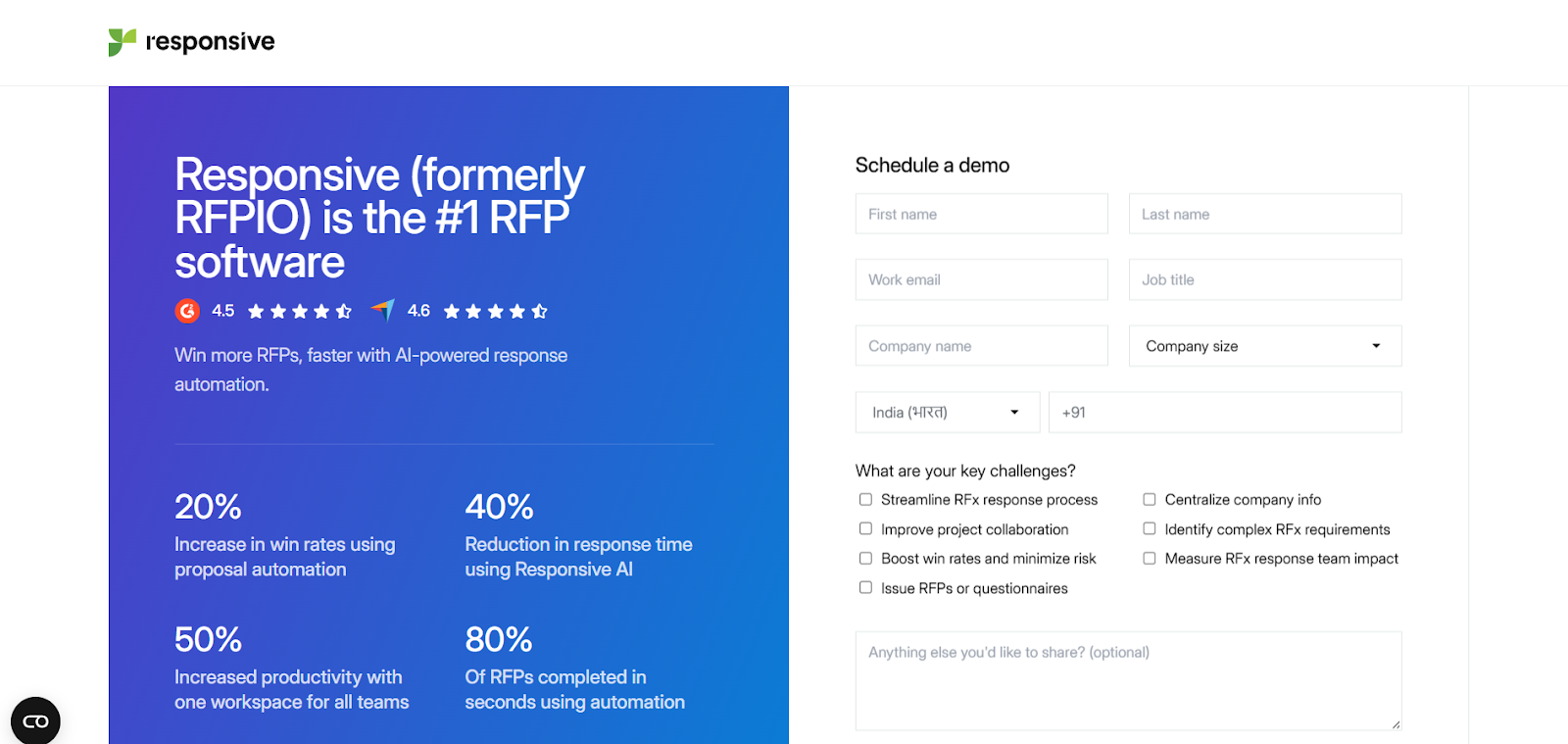
G2 Rating: 4.5/5
Responsive positions itself as a strategic response management platform with a strong emphasis on business intelligence and process optimization. Serving more than 2,000 organizations worldwide, it helps manage over $750 billion in opportunities annually.
Key Features
- Response Projects
Enables end-to-end bid and proposal collaboration with built-in workflow automation. - Requirements Analysis
Quickly evaluates whether incoming RFPs align with company capabilities and priorities. - Profile Center
Generates secure, pre-filled company documents to accelerate response times. - Lookup Functionality
Provides field teams with instant access to centralized knowledge and content. - Proposal Builder
Creates branded and accurate proposal templates that ensure consistent quality across submissions.
Pros
- Strategic focus that goes beyond automation into analytics and business intelligence
- Strong integrations with CRM, collaboration, and productivity platforms
- Proven ROI with reduced cycle times and measurable improvements in win rates
Cons
- Advanced analytics features can have a steeper learning curve
- Premium pricing may limit accessibility for smaller businesses
Pricing
Responsive offers three main editions:
- Emerging Edition: Designed for smaller businesses (fewer than 50 employees)
- Growth Edition: Built for mid-sized teams (up to 500 employees)
- Enterprise Edition: A full-featured platform for large global organizations
Best For
Responsive is best suited for revenue and proposal teams that prioritize data-driven decision making. Its analytics-driven features make it ideal for organizations that want to align RFP management closely with overall sales strategy and growth targets.
4. Qvidian (Upland)
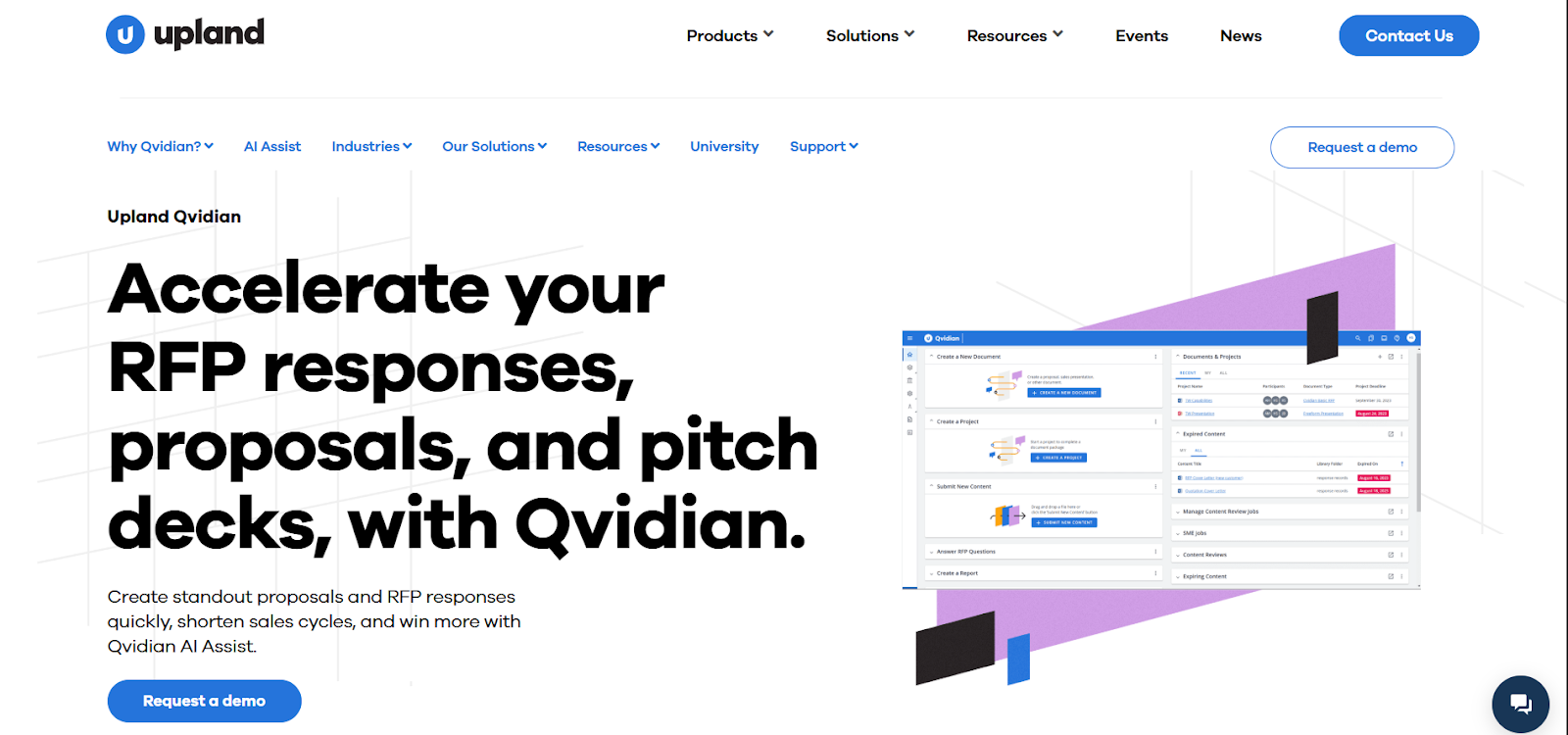
G2 Rating: 4.3/5
Qvidian is known for supporting large organizations with complex proposal requirements by providing a structured, governance-first approach.
Key Features
- Industry-Pioneering Automation
Auto-fills responses from a curated and approved content library. - AI Assist Functionality
Generates and revises answers with advanced generative AI to save drafting time. - Central Content Library
Stores thousands of pre-approved answers with version control for accuracy and consistency. - Virtual Team Collaboration
Built-in messaging and integrations streamline reviews and keep projects on track. - Professional Templates
Provides branded, consistent, and compliance-ready proposal formats.
Pros
- Decades of proven expertise in proposal management
- Comprehensive coverage of the full RFP lifecycle
- Advanced analytics with more than 70 standard and custom reports
Cons
- Traditional interface may feel less modern compared to AI-native platforms
- Designed primarily for enterprise-level teams rather than small vendors
Pricing
Qvidian offers custom pricing tailored to mid-market and enterprise organizations with structured proposal management needs.
Best For
Qvidian is best suited for large enterprises and professional services firms with formal, complex proposal operations. Its governance-first approach makes it a strong choice for teams that need consistency, structure, and compliance across high-volume or multi-departmental RFPs.
5. Proposify
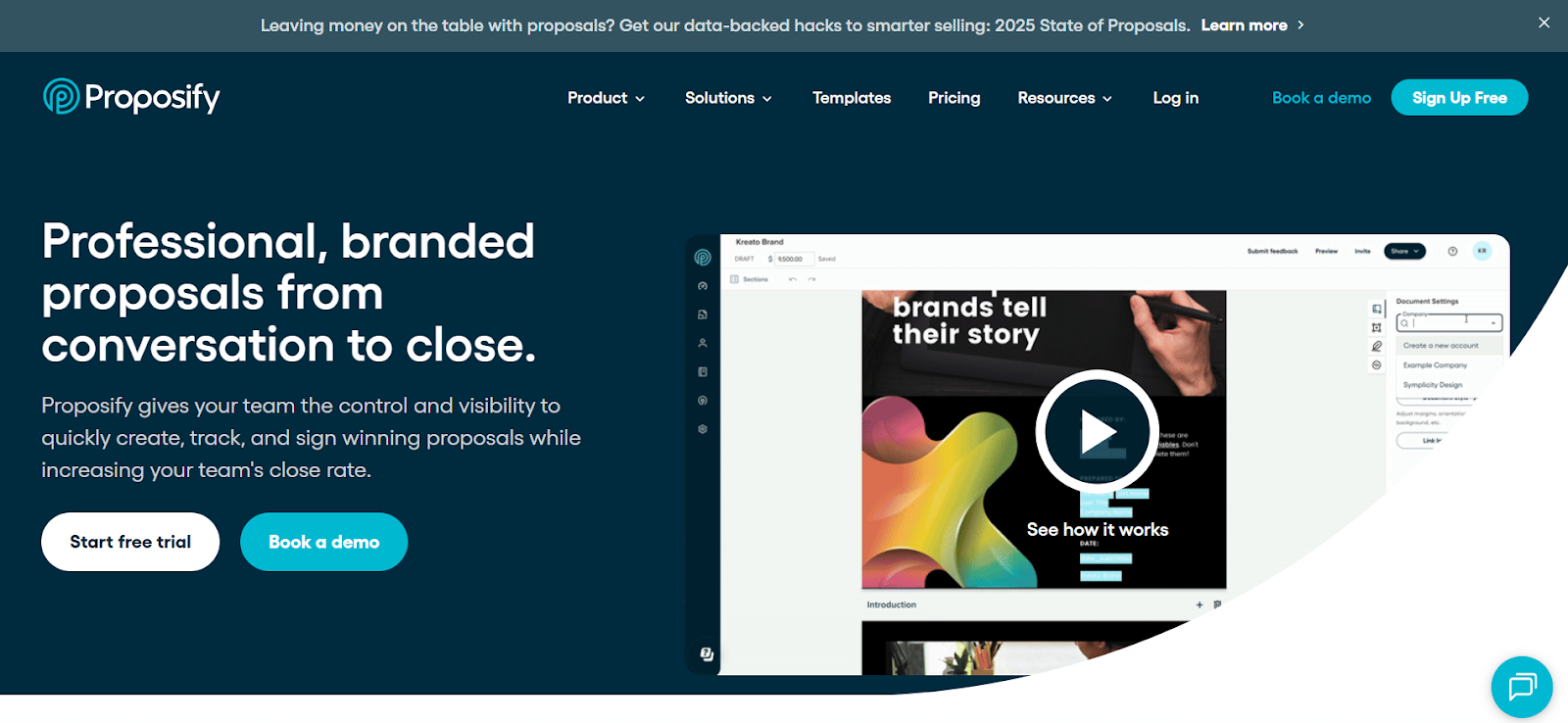
G2 Rating: 4.6/5
Proposify differentiates itself with its focus on visual proposal design and client experience. It enables teams to create polished, on-brand proposals that stand out to evaluators.
Key Features
- Document Automation
Ready-to-use branded templates for faster proposal creation. - Interactive Quotes
Built-in calculators reduce pricing errors and improve accuracy. - Contract Management
Includes redlines, markups, and approvals within the platform. - E-Signatures and Payments
Streamlines contract closure by enabling digital sign-off and integrated payments. - CRM Integration
Syncs directly with Salesforce, HubSpot, and other platforms to eliminate manual data entry.
Pros
- Strong visual impact enhances client perception
- Easy onboarding and quick implementation
- Transparent, predictable pricing
Cons
- Limited AI capabilities compared to Inventive AI or Responsive
- Not ideal for large-scale, automation-heavy RFP workflows
Pricing
- Basic: $19/user/month (annual billing)
- Team: $41/user/month (annual billing)
- Business: $65/user/month (annual billing)
Best For
Proposify is best for small and mid-sized vendors that prioritize presentation quality and client experience. It focuses less on compliance-heavy RFP workflows and more on helping businesses stand out with visually compelling and client-friendly proposals.
6. AutoRFP.ai

G2 Rating: 4.9/5
AutoRFP.ai takes a ground-up, AI-first approach rather than layering AI onto legacy systems. Its emphasis on scalability, multilingual support, and automation makes it a strong choice for organizations managing high volumes of proposals across global markets.
Key Features
- Instant AI Responses
Generates complete RFP drafts in seconds, accelerating turnaround times. - Real-Time Collaboration
Offers unlimited users to support seamless multi-stakeholder workflows. - Multi-Language Support
Supports over 30 languages, enabling consistent proposal responses across global regions. - Private AI Security
Built on Azure AI with advanced data sovereignty and security controls. - Comprehensive Integrations
Connects with Salesforce, Slack, Google Drive, and other enterprise tools.
Pros
- AI-native architecture designed for speed and scalability
- Unlimited users are included in all plans
- Strong multilingual capabilities for international teams
Cons
- Newer entrant compared to established players like Loopio or Qvidian
- Project-based pricing may increase costs for very high-volume RFP teams
Pricing
AutoRFP.ai offers pricing from $1,000 to $1,450 per month, depending on features and scale.
Best For
AutoRFP.ai is best suited for fast-growing companies and global enterprises that need instant draft generation, multilingual support, and AI-native speed to handle large-scale RFP workloads.
7. RocketDocs

G2 Rating: 4.2/5
RocketDocs is a compliance-focused SRM platform built for organizations in regulated industries such as finance, technology, and professional services. It combines automation with enterprise-grade security to ensure proposals are accurate, consistent, and audit-ready.
Key Features
- Smart Content Management
Centralizes and governs responses, certifications, and policies to maintain accuracy across submissions. - Real-Time Collaboration
Enables teams across sales, compliance, and IT to work together in a unified workspace. - Workflow Automation
Routes responses to the right subject matter experts, reducing bottlenecks and delays. - Integration Suite
Connects with CRMs, document management tools, and productivity platforms. - Audit-Ready Reporting
Tracks contributions and approvals to ensure full transparency and accountability.
Pros
- Purpose-built for compliance-heavy workflows
- Strong security features for enterprise responses
- Simplifies cross-team collaboration and review processes
Cons
- Smaller teams may find the compliance-first framework too rigid
- Less visually polished compared to design-focused tools like Proposify or PandaDoc
Pricing
Custom pricing based on organization size and complexity of requirements.
Best For
RocketDocs is best suited for mid-to-large enterprises managing complex RFPs, RFIs, and due diligence questionnaires where compliance and security are just as critical as speed.
8. PandaDoc
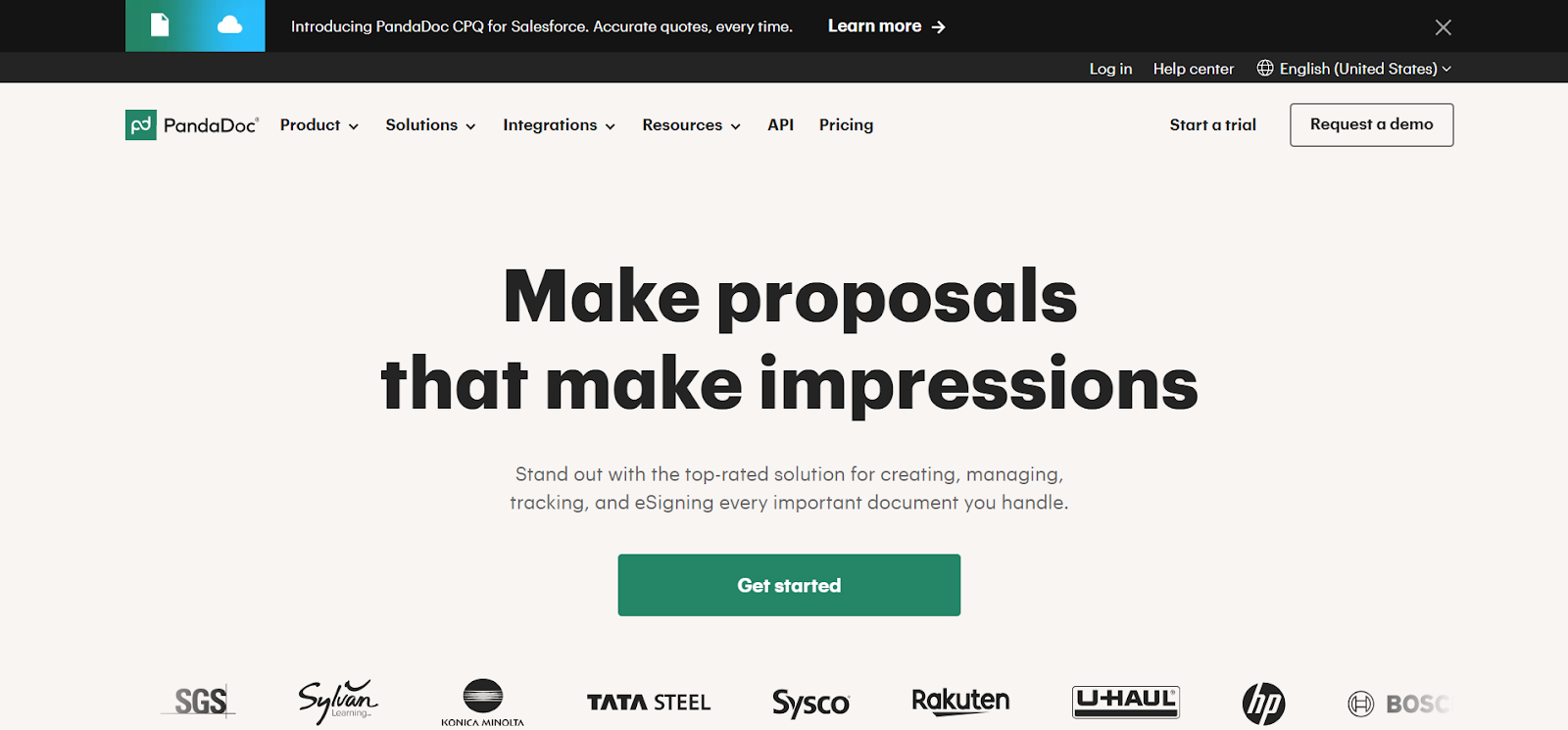
G2 Rating: 4.7/5
PandaDoc is widely recognized for its proposal automation and contract execution features, making it an all-in-one platform for organizations that value speed, simplicity, and streamlined client interactions.
Key Features
- Drag-and-Drop Builder
Easy-to-use templates that allow teams to quickly build branded proposals. - E-Signature Integration
Enables instant approvals without the need for additional contract tools. - Content Library
Stores standardized templates and boilerplate content for faster responses. - Real-Time Alerts
Notifies sales teams when clients view or sign proposals. - CRM and Payment Integrations
Connects with Salesforce, HubSpot, Pipedrive, Stripe, and other platforms.
Pros
- Intuitive design and quick implementation
- Combines proposals, contracts, and e-signatures in one platform
- Strong integration ecosystem across CRMs and payment tools
Cons
- Lighter on advanced SRM features such as compliance governance
- Better suited for SMBs than large-scale enterprise teams managing complex RFPs
Pricing
PandaDoc pricing ranges from $19 to $65 per user per month, depending on the plan.
Best For
PandaDoc is best suited for small to mid-sized organizations that need fast proposal creation and contract workflows rather than enterprise-level SRM governance.
9. Expedience Software

G2 Rating: 4/5
Expedience Software takes a Microsoft Word–native approach to SRM, embedding automation directly into the tool proposal teams use most. It is designed for teams that want automation without leaving Word.
Key Features
- Word-Native Automation
Builds and formats proposals directly inside Microsoft Word. - Content Insertion Automation
Inserts pre-approved responses, policies, and boilerplate content. - Branding Enforcement
Ensures proposals match corporate style and branding standards. - Copilot AI Integration
Provides AI-assisted drafting within Word for faster turnaround. - Lightweight Governance
Tracks usage of approved content to maintain consistency.
Pros
- Works entirely in Word, offering a familiar environment with a low learning curve
- Strong focus on branding and formatting compliance
- Lower deployment complexity compared to large enterprise platforms
Cons
- Limited scalability for very high-volume RFP teams
- Lacks advanced collaboration and analytics features
Pricing
Custom pricing is available based on licenses and feature requirements.
Best For
Expedience Software is best suited for mid-sized organizations that want to improve efficiency and branding consistency without migrating to a new platform or ecosystem.
10. Arphie
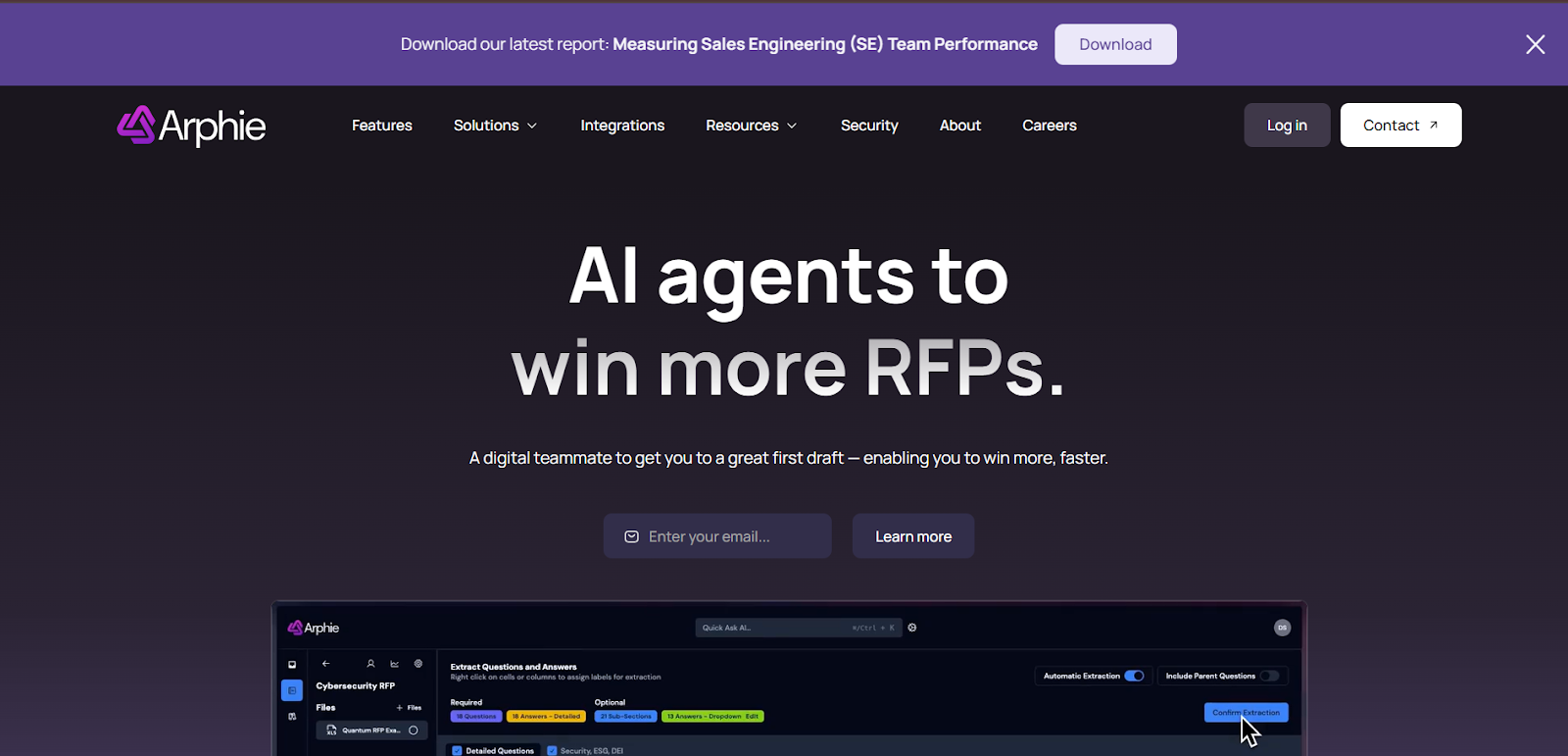
G2 Rating: 4.9/5
Arphie is an AI-enhanced SRM platform designed with a compliance-first architecture. It emphasizes automation, accuracy, and customizable workflows, making it a strong fit for organizations managing complex proposal requirements.
Key Features
- AI-Enhanced Content Workflows
Automates repetitive responses with high accuracy, reducing drafting time. - Custom Workflows
Role-based assignments ensure the right stakeholders review and approve content. - Scalable Automation
Handles both small proposal volumes and enterprise-scale demands. - Audit-Ready Reports
Tracks every submission for transparency and accountability.
Pros
- High accuracy with AI-first automation (up to 95 percent)
- Compliance-first architecture for organizations with strict standards
- Strong G2 rating reflects customer satisfaction
Cons
- Newer platform with a smaller ecosystem than established competitors
- Customization may require closer vendor involvement
Pricing
Arphie offers custom pricing tailored to organizational size and proposal volume.
Best For
Arphie is best suited for organizations that require AI-driven accuracy, compliance safeguards, and scalable workflows. It works well for mid-sized to enterprise teams where accountability and precision are critical to proposal success.
11. OrbitShift (rfpOS)
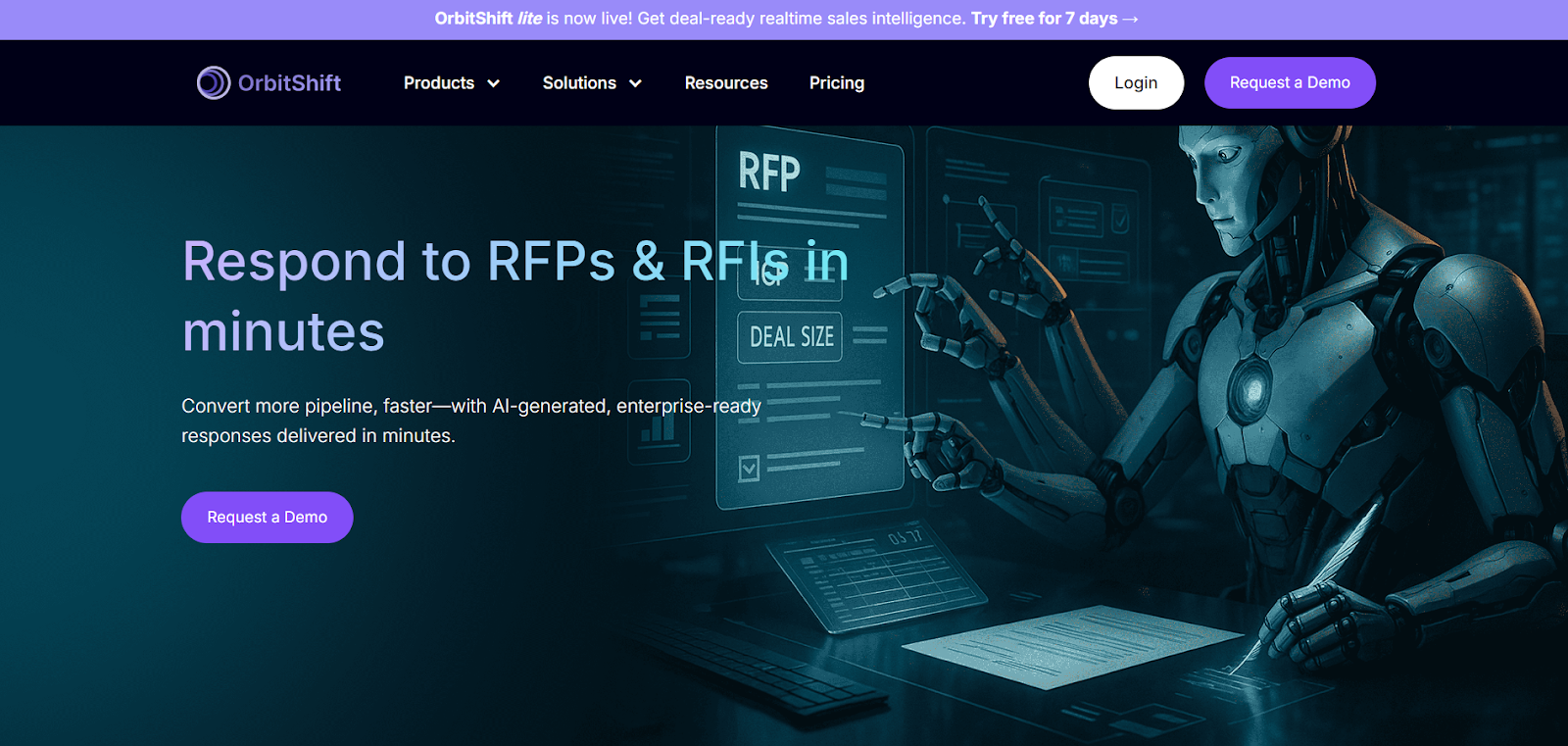
G2 Rating: 4.6/5
OrbitShift’s rfpOS is a multi-agent AI platform built for end-to-end deal management, including RFP automation. It provides a holistic view of the proposal lifecycle, helping teams streamline everything from intake to submission.
Key Features
- Multi-Agent AI Modules
Automates RFPs, RFIs, and due diligence questionnaires with high accuracy. - Bid Lifecycle Management
Tracks opportunities from initial intake through final submission. - Integrations
Connects with CRMs, productivity platforms, and workflow systems. - Team Collaboration
Assigns responsibilities across sales, operations, and technical contributors. - Analytics Dashboard
Offers visibility into pipeline performance, response quality, and team efficiency.
Pros
- Robust AI-driven multi-agent system
- Covers the entire deal cycle, not just RFP workflows
- Strong adoption among enterprise teams
Cons
- A broad feature set may be unnecessary for teams focused only on RFPs
- Newer entrant compared to established platforms like Loopio or Qvidian
Pricing
Custom pricing available based on team size and feature requirements.
Best For
OrbitShift (rfpOS) is best suited for enterprises managing complex, multi-stage deal cycles. It is ideal for organizations that want end-to-end automation and visibility across every phase of the proposal process.
12. 1up
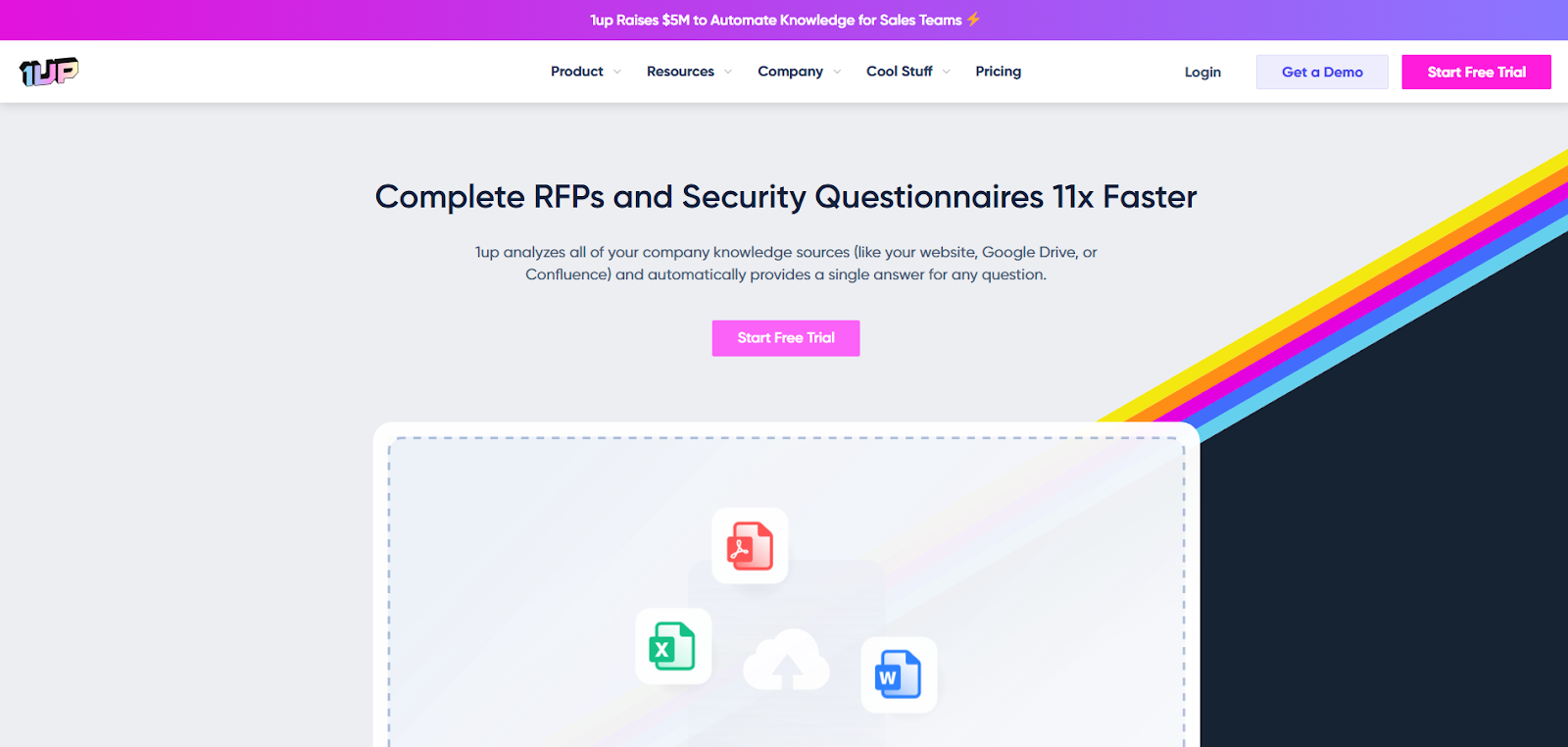
G2 Rating: 4.9/5
1up is an AI-native SRM tool designed to deliver instant responses for RFPs, RFIs, and security questionnaires. It focuses on ease of use, scalability, and high accuracy, making it a strong choice for teams looking for speed and simplicity.
Key Features
- Instant AI Response Drafting
Generates contextually accurate answers in seconds, reducing manual effort. - Pre-Approved Content Libraries
Maintains consistency and compliance across responses. - Security-First Workflows
Provides strong governance and data protection for sensitive proposal processes. - Scalable Automation
Handles high RFP volumes with minimal manual input. - Simple Integrations
Connects easily with CRMs, content repositories, and document management systems.
Pros
- Very high G2 rating (4.9/5) reflects strong customer satisfaction
- Designed for speed and simplicity with minimal setup required
- Scalable to support growing RFP workloads
Cons
- Newer compared to long-established providers like Qvidian
- May lack some advanced analytics features
Pricing
Custom pricing, typically tailored to small-to-mid-sized organizations and fast-scaling enterprises.
Best For
1up is best suited for organizations that need ultra-fast, AI-first proposal responses without the complexity of large enterprise platforms. It is particularly valuable for teams that prioritize speed, accuracy, and simplicity in their RFP workflows.
Before choosing a platform, it’s important to understand the must-have features that make SRM software truly effective.
Must-Have Features in Top Software Solutions for Strategic Response Management
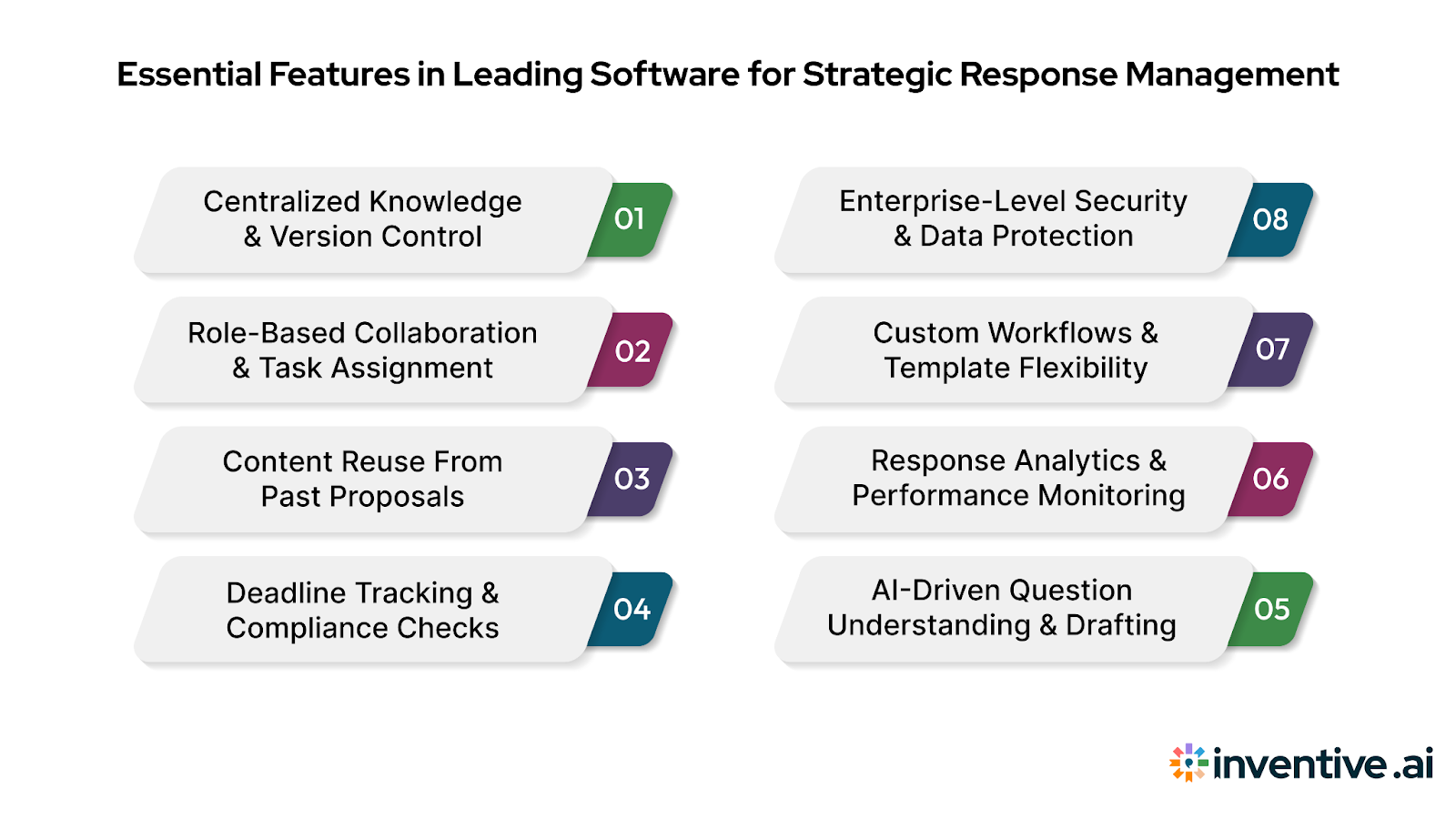
Every lost RFP is a missed revenue opportunity. Sales and proposal teams can’t afford inefficiencies, duplicate work, or last-minute scrambles. These features directly impact deal velocity, win rates, and the ability to meet buyer expectations with tailored, on-brand responses—at scale and under pressure.
1. Centralized Knowledge Management and Version Control
What it is: A shared content repository where all approved answers, boilerplates, and past responses are stored, updated, and tracked.
How it helps: When proposals pull answers from different teams, inconsistent messaging and outdated content can creep in. A centralized system ensures everyone uses the same, verified material—no duplicates, no conflicting versions.
Benefits:
- Speeds up drafting with ready-to-use content
- Reduces back-and-forth and manual checks
- Maintains accuracy across all proposals
Ease: Writers don’t waste time digging through old emails or docs. Approved responses are just a search away, always up to date.
Tired of clunky RFP tools that slow your team down? With Inventive AI, you can cut response times by 90%, boost win rates by 50%, and reduce manual effort by 70% with AI-powered drafting and seamless collaboration.
Request a demo today and experience faster, smarter, and more consistent RFP responses.
2. Role-Based Collaboration and Task Assignment
What it is: A workflow system where tasks are assigned to specific team members based on expertise—legal, finance, product, etc.
How it helps: When multiple people need to contribute, clarity in roles and deadlines avoids last-minute confusion or missed sections.
Benefits:
- Smooth handoffs between teams
- Visibility into task ownership and deadlines
- Reduces revision cycles
Ease: Everyone knows what to work on, when it's due, and where to do it—all in one system.
3. Content Suggestion and Reuse from Previous Proposals
What it is: A smart system that auto-suggests relevant answers based on previously submitted or approved content.
How it helps: Much of what’s asked in RFPs is repetitive. Instead of rewriting the same response, teams can reuse content that already worked.
Benefits:
- Saves time on common questions
- Keeps responses consistent in tone and accuracy
- Reduces dependency on senior writers
Ease: Typing just a few words surfaces complete answers, saving hours of drafting.
Also Read: How to Write a Winning RFP
4. Deadline Tracking and Compliance Checks
What it is: Built-in tools that highlight what’s missing, flag incomplete sections, and monitor if submissions meet requirements.
How it helps:
RFPs often include strict format and content requirements. Forgetting even one compliance item can disqualify a proposal.
Benefits:
- Prevents submission errors
- Improves accountability
- Keeps progress visible at all times
Ease: No more manually checking checklists. The system alerts teams when something’s off or incomplete.
5. AI-Powered Question Understanding and Draft Generation
What it is:
An AI assistant that analyzes complex RFP questions, identifies intent, and drafts accurate responses using contextual data.
How it helps:
Questions aren’t always direct. AI breaks them down, recommends the right tone or detail level, and fills in first drafts quickly.
Benefits:
- Reduces the time taken to understand and respond
- Improves the quality of first drafts
- Flags vague or problematic wording early
Ease: Writers focus on refining answers instead of figuring out what the question means from scratch.
6. Response Analytics and Performance Tracking
What it is:
A dashboard that shows response timelines, content usage frequency, win rates, and team contribution stats.
How it helps:
Knowing what type of content performs well or which steps delay submissions helps teams make informed process improvements.
Benefits:
- Identifies which content closes more deals
- Highlights inefficiencies in the workflow
- Guides continuous improvement
Ease: No need to guess what’s working. The data shows where to focus and what to fix.
7. Custom Workflows and Template Flexibility
What it is:
A setup that allows teams to define their own approval processes, templates, and question structures.
How it helps:
Different industries or clients may demand unique formats or sequences. Pre-built workflows can’t cover every case.
Benefits:
- Adapts to company-specific needs
- Supports multiple regions or business lines
- Reduces the learning curve for new RFP formats
Ease: Teams don’t waste time wrestling with rigid templates. They work within systems built for how they respond.
8. Enterprise-Level Security and Data Protection
What it is:
End-to-end encryption, access controls, and activity logs that safeguard sensitive client and company data.
How it helps:
RFPs often contain proprietary information. Any breach can affect trust, compliance, or revenue.
Benefits:
- Protects against unauthorized access
- Ensures audit readiness
- Builds client confidence
Ease: Security doesn’t interrupt workflows. Teams collaborate freely, knowing the system guards the data in the background.
Knowing these must-have features helps us explore the top software solutions available for strategic response management in 2025.
With an overview of leading features, the next step is to evaluate and select the right RFP software tailored to your organization’s needs.
Evaluating and Choosing the Right RFP Software for Strategic Response Management
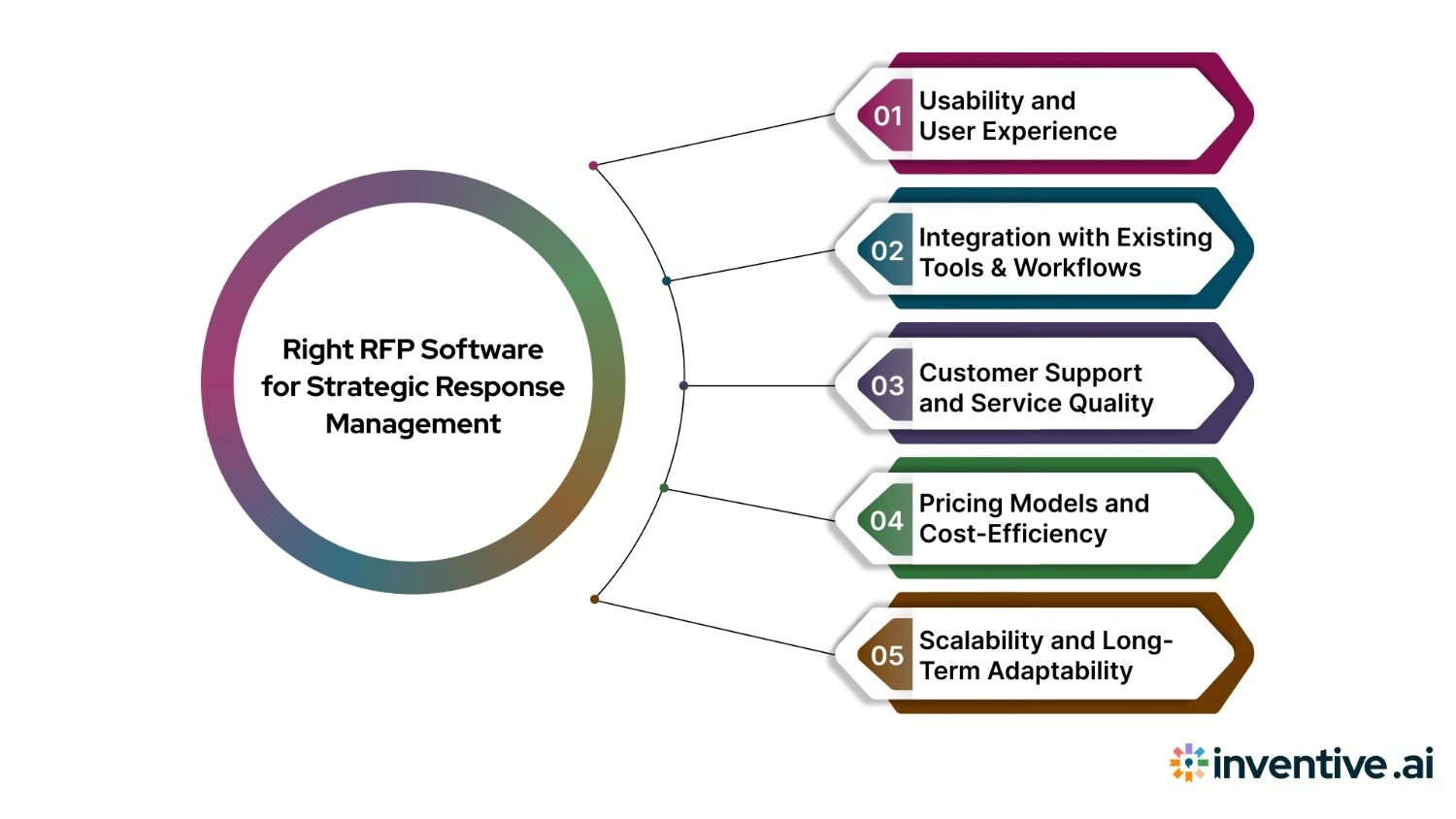
Choosing the right software for Strategic Response Management (SRM) requires aligning your team’s specific needs with the capabilities of available tools. The decision hinges on usability, integration, support, cost, and scalability. This guide helps you evaluate options against these criteria so you can select a solution that boosts efficiency and win rates without causing operational friction.
1. Usability and User Experience
Usability directly impacts how quickly your team can adopt the software and start delivering results. A steep learning curve or clunky interface can delay onboarding and reduce productivity. Look for:
- Intuitive interfaces that require minimal training.
- Quick onboarding processes to get sales, proposal, and solutions teams up to speed.
- Mobile or remote access to enable work on-the-go.
- Clear workflows that reduce complexity for cross-functional collaboration.
If your team includes many new users or less technical members, prioritize platforms with simple design and comprehensive training resources. For example, Responsive.io offers fast onboarding with an easy-to-navigate interface, while Inventive AI combines advanced AI with user-friendly workflows.
2. Integration with Existing Tools and Workflows
Your RFP software should fit seamlessly into your current technology stack to avoid duplicating efforts or creating bottlenecks. Key points to assess include:
- Native integrations with CRM systems (Salesforce, Microsoft Dynamics), ERP, and document management platforms.
- Availability of APIs for custom workflows or connecting to internal tools.
- Data synchronization frequency and bidirectional updates to maintain consistency.
- Compatibility with communication tools like Slack or Microsoft Teams.
If your sales or revenue teams rely heavily on a specific CRM, choose software like Responsive.io (Salesforce integration) or QorusDocs (Microsoft stack) that provides deep, native connections.
3. Customer Support and Service Quality
Reliable support ensures your team can quickly resolve issues and maintain momentum during critical bid cycles. Evaluate vendors based on:
- Onboarding assistance and training programs.
- Availability of live chat, phone support, or dedicated account managers.
- Service level agreements (SLAs) guarantee response times.
- Access to knowledge bases, user communities, or proactive product updates.
If you operate in a high-stakes environment where downtime or errors are costly, prioritize vendors with comprehensive support packages, like Inventive AI or RFPIO.
4. Pricing Models and Cost-Efficiency
Understanding the pricing structure helps prevent unexpected costs and ensures the solution fits your budget. Consider:
- Per user licenses versus per project or flat fee models.
- Setup fees, training costs, and any extra charges for integrations.
- Total Cost of Ownership (TCO) over 1–3 years including maintenance and upgrades.
- Flexibility to scale pricing as your team or volume of RFPs grows.
If cost predictability is crucial, flat fee or bundled plans might be preferable. Smaller teams might benefit from scalable options offered by platforms like RFPIO.
5. Scalability and Long-Term Adaptability
Your RFP software should evolve as your organization grows and market demands shift. Focus on:
- Support for increasing user numbers and more complex workflows.
- Regular product updates, adding new features and security patches.
- Ability to customize templates, workflows, and integrations over time.
- Vendor commitment to innovation, such as incorporating AI enhancements.
If you expect rapid growth or complex SRM needs, select tools with proven scalability like Inventive AI or Loopio, which continuously update to meet enterprise demands.
Also Read: Top 5 Examples of Sales RFP Workflow Automation with AI
After selecting the best tools, it’s crucial to stay informed about emerging trends shaping the future of strategic response management.
Trends and the Future of Strategic Response Management
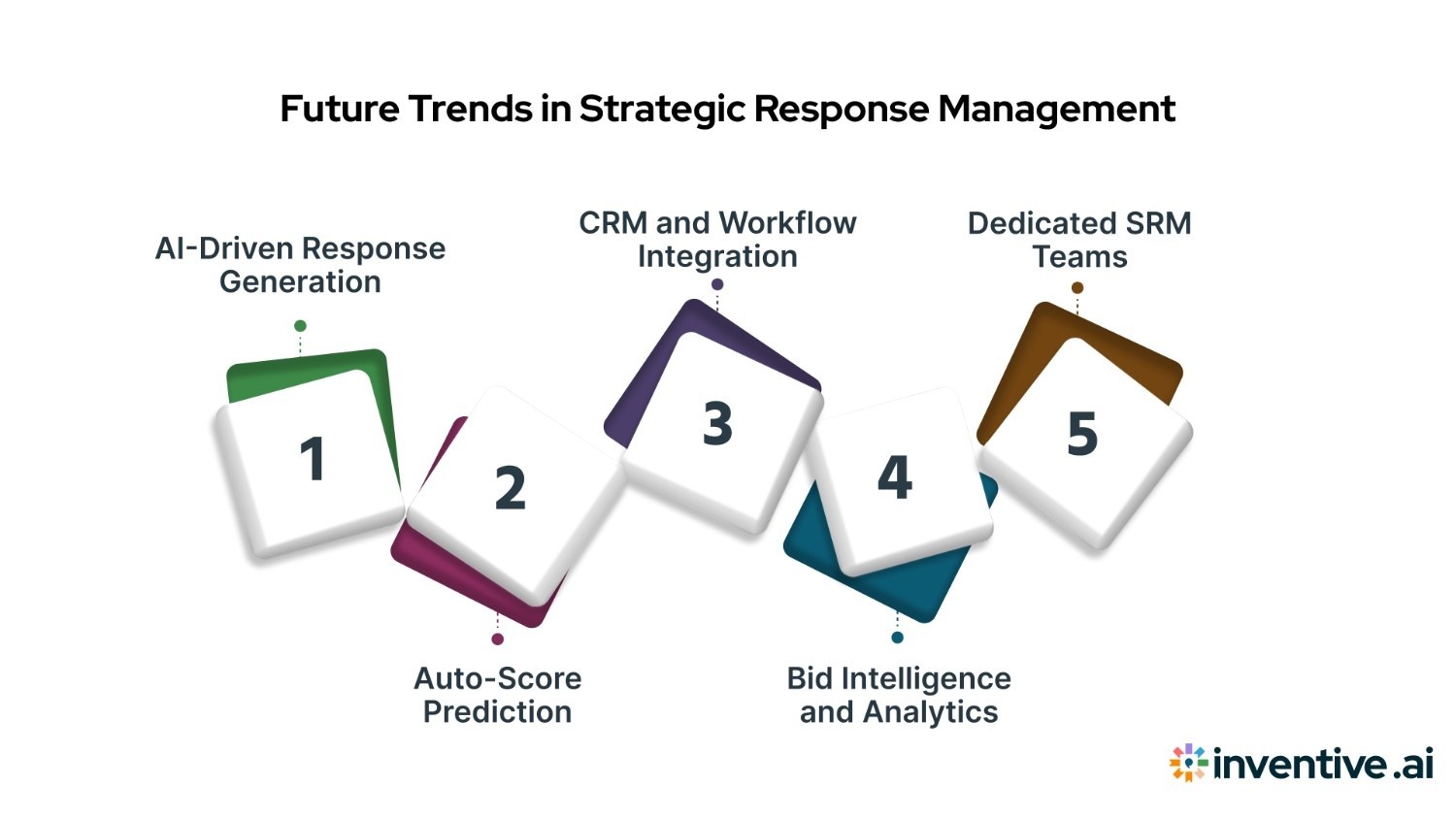
Strategic Response Management (SRM) now relies heavily on advanced technology to handle growing RFP complexity while improving efficiency and win rates. While overall staffing investment in SRM dropped from 70% to 48% year-over-year, leading companies buck this trend by simultaneously investing in technology (77%) and talent expansion (69%). In contrast, less mature organizations tend to underinvest in staffing, limiting their ability to scale effectively.
Key 2025 trends include:
- AI-Driven Response Generation: Automates first drafts and suggests content, cutting response time by up to 90%.
- Auto-Score Prediction: Uses machine learning to forecast bid success probability, guiding prioritization and resource focus.
- CRM and Workflow Integration: Ensures real-time syncing of sales data with RFP responses, reducing manual entry and misalignment.
- Bid Intelligence and Analytics: Provides actionable insights on team performance, win rates, and content usage to drive continuous improvement.
- Dedicated SRM Teams: Reflecting the complexity of modern RFPs, specialized teams handle coordination, compliance, and quality control at scale.
Tools like Inventive AI lead in these areas by combining AI-powered drafting with advanced analytics and deep CRM integrations, enabling sales, revenue, and proposal teams to respond faster and more strategically. As these trends accelerate, organizations adopting comprehensive SRM platforms will gain measurable advantages in both speed and win rates.
What Customers Say About Inventive AI:
Conclusion
Managing Strategic Response Management remains challenging due to its complexity and the need to coordinate multiple teams, deadlines, and compliance requirements. Modern SRM tools address these challenges by automating workflows and improving collaboration.
Among the top solutions, Inventive AI stands out for its AI-powered accuracy and speed, making it a leader in transforming RFP processes. Evaluating these platforms through demos or trials is a critical next step to ensure the best fit and smooth onboarding.
Investing in SRM software drives significant cost savings by reducing manual effort and errors. Teams see up to a 50% increase in win rates, better alignment across departments, and faster turnaround times. Additionally, these tools support audit readiness with detailed tracking and reporting while providing analytics that improve future forecasting and strategic planning.
FAQs
Q. How can AI-powered SRM tools reduce the time spent on RFP responses?
A: AI tools automate initial drafting by pulling from past responses and internal databases, cutting down manual writing. This allows teams to focus on customization and strategic input, speeding up the entire process.
Q. What role does integration with CRM and collaboration platforms play in SRM software?
A: Integrations sync customer and deal data directly into RFP workflows, reducing duplicate work and ensuring proposal content aligns with sales strategies. Collaboration tools keep cross-functional teams coordinated in real time.
Q. How do version control and content management improve proposal quality?
A: Version control prevents conflicting or outdated content by tracking changes and maintaining a single source of truth. Content management flags stale information, ensuring every response reflects the latest company standards.
Q. Why is scalability important when selecting an SRM platform?
A: Scalability ensures the tool grows with your team size and complexity, supporting more users, diverse workflows, and increasing RFP volume without performance loss or process bottlenecks.
Q. How do analytics in SRM software help improve win rates?
A: Analytics dashboards provide insights into response times, team performance, and proposal outcomes. These metrics help identify bottlenecks and optimize future responses for better alignment with client expectations.


